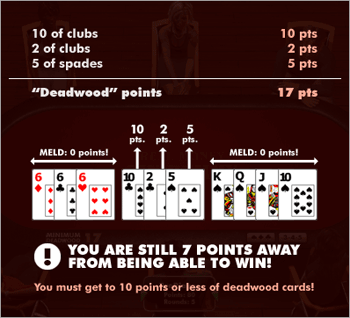Game Instructions
The Object of the Game
The object of Gin Rummy is to arrange your 10 cards into sets as quickly as possible so that you can end the hand (or knock) before your opponent does, and accumulate points.
Once a player has knocked, the points are automatically calculated, a winner for the hand is declared, and the overall scores are updated. These hands continue until a player reaches the target score for the room. They have then won the game.
A set consists of 3 or more cards of the same value (e.g. 2-2-2 or K-K-K-K), or 3 or more consecutive cards of the same suit (e.g. A-2-3 of spades or 7-8-9-10-J of diamonds). A card can only be part of one set at a time. Aces are low. Cards which are not part of a set are called deadwood.
Note - one deck of cards is used in this game.
Order of Play
At the start of a hand, 10 cards are dealt to each player, 1 card is laid face-up (this is the open pile), and the rest of the cards are laid face down (this is the stock pile). It is then the first player's turn.
For most of the game, a turn consists of taking a card from either the stock pile or the open pile, adding it to your hand, and then discarding an unwanted card to the open pile. If you take the open pile card, you may not discard it again straight away.
At the start of the game the first player may only take a card from the open pile. If they do not want this card they can click the 'Pass' button and offer it to their opponent. If their opponent does not want it either, they can Pass back, and the first player can take a card from the stock pile instead. From then on, play continues as above.
If a hand takes a particularly long time to complete, the stock pile may run out of cards. If it ever gets down to 2 cards then the hand is abandoned, the cards are shuffled and dealt again.
Knocking (ending a hand)
Once a player has collected the cards they need to complete their sets, they can knock to end the hand. A player may only knock if the total value of the deadwood cards in their hand (those cards not in sets) is equal to 10 or less (though note the exception of Oklahoma Gin below). The value of each card is as follows:
Ace: 1 point
2 - 10: Face value (e.g. a 4 = 4 points)
J, Q, K: 10 points
Knocking is done at the end of your turn by discarding your extra card to the knock pile, instead of the open pile. If you try to knock and your deadwood value is greater than 10, you will be informed and asked to discard to the open pile instead (though note the exception of Oklahoma Gin below). If you knock with no deadwood, this is called Gin.
Once a player has knocked, their cards are automatically laid face-up on the table and sorted into sets and deadwood. If the player has not got Gin, their opponent may lay-off their deadwood cards.
Laying-off
Laying-off is an automatic process whereby any deadwood in the opponent's hand is placed onto the sets of the player who knocked, wherever possible. For example, if one of the sets a player knocks with is 7-7-7, and the opponent has the other 7, this 7 is placed onto the knocking player's hand and the value is deducted from their own deadwood total.
Scoring
The player who wins the hand is the one who has the lowest deadwood total. The difference between the 2 totals is the winning player's score for that hand.
The knocking, laying-off and scoring system is demonstrated below:

There are also 2 ways of earning additional points. If the knocking player has Gin they earn a 25 point bonus, and if the deadwood value of the player who laid-off their cards is less than or equal to the deadwood value of the knocking player, they earn a 25 point undercut bonus.
Winning the Game
Once these points have been added to the overall scores, play continues with further hands until one of the players has reached the target score for the room (which is shown on the Gin Rummy games page and in the wager details box in the top left corner of the table). This player has then won the game.
Oklahoma Gin
Note that in the Oklahoma version of Gin, the minimum deadwood points required to knock is variable each new game, according to the first face card showing that hand. For example, a 7 showing would mean that all cards not in sets would need to leave deadwood totalling 7 points max before you can knock. An ace as the first card up would require both players to make gin to knock, i.e. zero deadwood points with all cards in melds.








